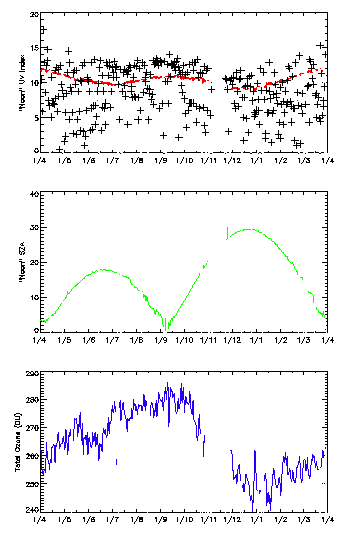
Previous: Comparison with RT Model Calculations Next: Conclusions Up: Ext. Abst.
Annual Variation
The annual variation in UV insolation at Paramaribo is modulated by the variation in solar zenith angle (sza), Sun-Earth distance, ozone column and cloudiness. At Paramaribo the sun crosses the zenith at local noon twice a year: in April and September (Figure C). The difference in UV insolation between both cycles is partly compensated by the Sun-Earth distance which is smallest in January and yields about 6\% more UV in January than in July. The bimodal distribution due to the variations in sza is partly compensated by the annual cycle in the ozone column: the maximum ozone column in September coincides with the minimum sza. The scattered UV measurements show that a cloud-free noontime is the exception at Paramaribo, even in the dry seasons (Feb-Mar;Aug-Nov). The maximum UV Index measured in Paramaribo thus far is 17.5 on 4th of April 1999, in partly cloudy conditions.

Figure 3. One year (1 Apr 1999 - 1 Apr 2000) of UV Index (top) and total ozone (bottom) measurements at Paramaribo. The figure in the middle gives the solar zenith angles of the spectrum for which the UV Index was determined, which is the first spectrum after noontime on each day. For comparison, in red, in the top figure, the UV Index is given as calculated with a regression method based on total ozone and sza as applicable at mid-latitudes.